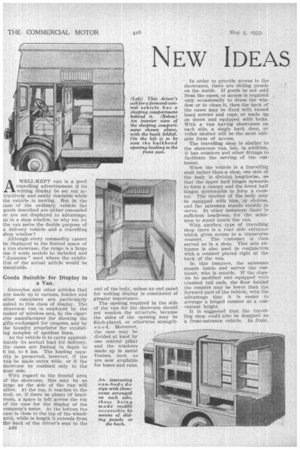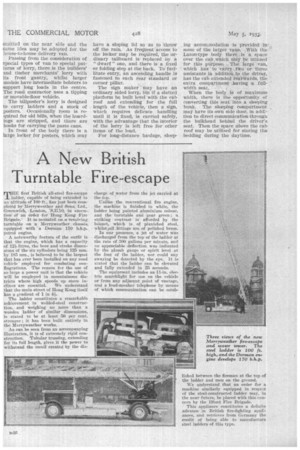NEW IDEAS
Page 118

Page 119

Page 120

If you've noticed an error in this article please click here to report it so we can fix it.
IN SPECIAL BODIES
Meeting the Demand for Mobile Shops and Showcase Vans, Vehicles Specifically Designed for Houseto-house Delivery, Bodywork for Billposters and Sign Makers, and Sleeping Accommodation on Long distance Lorries
AWELL-KEPT van is a good travelling advertisement if its writing display be set out attractively and easily readable while the vehicle is moving. But in the ease of the ordinary vehicle the goods described are either concealed or are not •displayed to advantage, as in a shop window, 80 why not let the van serve the double purpose of a delivery vehicle and a travelling shop -window?
Althoughevery commodity cannot be displayed in the limited space of a van showcase, the range is a large one if scale models be included and `! dummies" used where the exhibition _of the actual article would be unsuitable.
Goods Suitable for Display in a Van.
Groceries and other articles that are made, up in cartons, bottles and other containers are particularly suited to this class of display. The showcase van is employed by the maker of wireless sets, by the -cigar, ette manufacturer for showing the gifts exchanged for coupons, and by the laundry proprietor for exhibiting samples of spotless linen.
As the vehicle is to carry approximately its normal load for delivery, the cases are limited in depthto
6 ins. to 8 ins. The loading capacity is preserved, however, if the van be made extra wide, or if the showcase be confined only to the near side.
With regard to the frontal area of the showcase, this may be as large as the side of the van will allow. At the top, it reaches to the roof, or, if there be plenty of headroom, a space is left across the top of the ease for the display' of the company's name. At the bottom the case is close to the top of the wheelarch, while in length it extends from the back of the driver's seat to the D44 end of the body, unless an end panel for writing display is considered of greater importance.
The opening required in the side of the van for the showcase should not weaken the structure, 'because the sides of the opening, may be flitch-plated, or otherwise strengthe n e d. Moreover, the case may be divided at least by one central pillar and the windows made up in metal frames, such as are now available for buses and vans.
In order to provide access to the showcases, there are sliding panels on the inside. If goods be nit sold from the cases, or access is required only occasionally to dress the window or to clean-it, then the back of the cases may be fixed with raised head screws and cups, or made up as doors and equipped with locks. With a van having showcases on each side, a single back door, or roller shutter will be the most suitable form of access.
The travelling shop is similar to the showcase van, but, in addition, it has counters and other fittings to facilitate the serving of the cus tomer. .
When the vehicle is a travelling stall rather .than4t shop, one side of the body is divided, lengthwise, so that theupper half hinges upwards to form a canopy and the lower half hinges downwafds to form a counter. The interior of the body may be equippedwith bins, or shelves, and the salesman stands outside to serve. In other instances there is sufficient headroom for the salesman to stand inside the van.
With another.type .of travelling shop there is a rear. side entrance which gives access to a transverse counter. The customer is then served as in a shop. This side entrance is also used in conjunction with a counter placed right at the back of the van.
In this instance, the salesman stands inside and serves the -customer, who is outside. If the chassis be modified and equipped with cranked tail ends, the floor behind the counter may be lower than the forward part of the vehicle, with the advantage that it is easier to arrange a hinged counter at a convenient height.
It IS suggested that the travelling shop could also be designed a8 a front-entrance vehicle. In front, the size of the doorway is not limited by the space available between the back of the wheel-arch and end of the body, also extra snace is available by encroaching on the driver's compartment.
The driver's seat is similar to that of a front-entrance bus, extending only from the off side to the longitudinal centre of the body, or as far as is necessary to provide a comfortable driving position. On entering the front door, the counter is on the right and a vestibule is formed by the partition behind the driver's seat. In order that the customer just served shall not obstruct the one who is entering the van, an offside door icould be (provided and "one-way traffic" maintained. With a travelling shop, easy access to a side showcase is an advantage. The showcases may have glazed backs so as to improve the lighting of the interior, or, if confined to the near side, shelves for the storage of goods may be arranged on the off side. The van should have a clerestory roof, with windows at the sides and ends, or a plain cambered. roof high enough to enable small windows to be inserted above the top line of the showcases. With a front entrance, a back door is not essential, and this part of the body may be fitted out with shelves. The driver's compartment has its own off-side door, but, as there is already a door in front on the near side, a second door for the driver may be omitted.
Another variety of specialized boxvan is that which is used for houseto-house delivery. There should be easy access to both sides and to the back of the vehicle, also to the driver's seat.
According to the length of the body, the side is divided into two or three openings, . which are equipped with sliding panels or roller shutters. The panels slide horizontally, or are pivoted at the top and are swung outwards and then pushed inwards under the roof. The back of the body is enclosed in a similar manner.
Ample Accommodation in House-to-house Vehicles.
Usually, the body has an intermediate floor, which is solid or Slatted, according to the class of goods carried. Any space available below the main floor at the sides and back may be used for lockers for extra stock, whilst the roof is enclosed by a rail and has wearing slats for carrying empties.
For easy access to the driver's seat, a low floor line is desirable. For this reason some electric chassis have been specially designed with a deep crank to the frame under the driver's compartment.
The punctual delivery of newspapers over a wide area requires a van with a quickly negotiated doorway. To ensure this the door is omitted on the near side and the same idea may be adopted for the house-to-house delivery van.
Passing from the consideration of special types of van to special patterns of lorry, there is the builders' and timber merchants' lorry with its front gantry, whilst larger models have intermediate bolsters to support long loads in the centre. The, road contractor uses .a tipping or movable-floor vehicle.
The billposter's lorry is designed to carry ladders and a stock of posters. Occasionally room is required for old bills, when the hoardings are stripped, and -there are hooks for carrying the paste cans.
In front of the body there is a large locker. for posters, which may have a sloping lid so as to throw off the rain. As frequent 'acceSs to the locker May be required, the -ordinary tailboard is replaced by a " dwarf " one, and there is' a fixed or folding step at the back. To facilitate entry, an ascending handle is fastened to each rear 'Standard or corner pillar.
The sign maker -may have an ordinary sided lorry• bin if a slatted platform be built level with the cab roof and extending for the full length of the vehicle, then a sign, which requires delicate handling until it is fixed, is carried safely, with the advantage that the interior of the lorry is left free for other items of the load.
For long-distance haulage, sleep ing accommodation is provided .insome of the larger vans. With the Luton-type body there is a space over the cab which may be utilized for this ptirPose:The large • van, which has to 'carry .'two orthree assistants in addition to the driver, has the 'cab -eXtentledrearWards, the extra compartment itaving va
width seat.. ' ;' .
When the body. is. of maximum width, there is 'the opportunity of converting this seat' into a sleeping bunk. The sleeping compartment may have its own side door, in addition to direct communication through the bulkhead behind the driver's seat. Then the space above the cab roof may be utilized for storing the bedding during the daytime.




























































































































































































